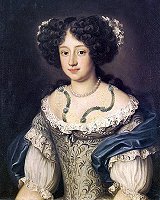Fembio Specials Famous Women from Hanover, Germany Sophie Dorothea von Braunschweig-Lüneburg
Fembio Special: Famous Women from Hanover, Germany
Sophie Dorothea von Braunschweig-Lüneburg

(Sophie Dorothea, Kurprinzessin von Hannover, genannt Prinzessin von Ahlden; Sophie Dorothea, Gräfin von Wilhelmsburg)
Born 25 August 1666 in Celle
Died 23 November 1726 at Ahlden Castle near Celle
Princess-Elector of Hanover
Biography
Sophie Dorothea was 16 when she was married to her cousin Georg Ludwig of Hanover. A payment of 10,000 thalers annually to father-in-law Ernst August, the signing over of all her property holdings and the prospect of taking over the rule of the principality of Celle permitted the Hanoverian court to overlook the dynastic blemish of her illegitimate birth. With the birth of a male heir a year later the Princess-Elector had fulfilled her duty, and her husband turned his attentions back to his mistresses.

Sophie Dorothea, born on 25 August 1666, was a fun-loving and attractive young woman. The only child of Duke Georg Wilhelm of Celle and “the Frenchwoman,” as Eleonore d’Olbreuse was derogatorily known in Hanoverian court circles, she was raised to be quite aware of her station and high value in the marriage market.
The Leine Castle in Hanover served as residence of the royal family. And here everyone knew everyone and observed everything. Spying, intrigues and romances made for a constantly bubbling rumor mill in and around the castle. Even the ladies were allowed to have affairs, as long as they followed the rules of the game. It was not seemly for a woman to become involved with a man beneath her social standing, nor could she experience actual love for him.

Sophie Dorothea transgressed these unwritten rules when she began a love affair during the carneval celebration in 1691 with Count Philipp Christoph Königsmarck. The Swedish cavalier and war hero, an officer at the Hanoverian court, was young, rich, extravagant and exceedingly handsome.
The “affair serjos,” as he referred to it, went on for four years and was a time of intense love between the Princess-Elector and the nobleman of lower rank, during which they also exchanged passionate, encoded love letters. There had been plenty of warnings before Königsmarck finally disappeared on 11 July 1694 during a visit to the castle. Although his corpse was never found, much points to the likelihood that he was killed.

After the disappearance of Königsmarck Sophie Dorothea was confined at the “Amtshof” Ahlden near Celle. Found guilty of “intentional and malicious desertion and refusal to perform conjugal intercourse,” she was divorced and never saw her children again. For 32 years, till her death on 23 November 1726, the “Princess of Ahlden” lived in banishment as a prisoner of the state.
trans. Joey Horsley
For additional information please consult the German version.
Author: Barbara Fleischer
If you hold the rights to one or more of the images on this page and object to its/their appearance here, please contact Fembio.


